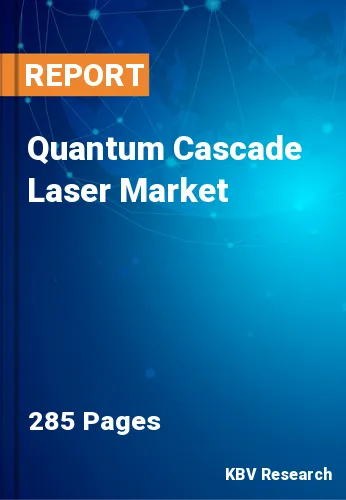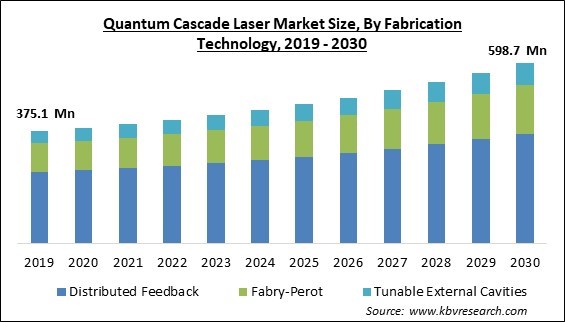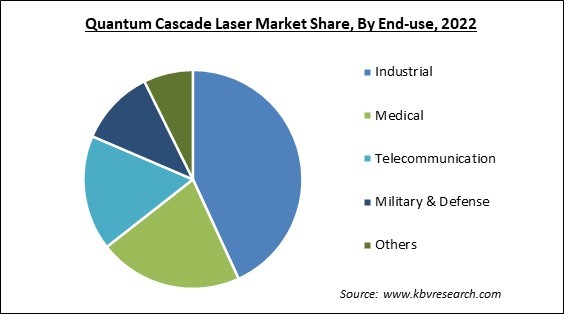
The Global Quantum Cascade Laser Market size is expected to reach $598.7 million by 2030, rising at a market growth of 5.0% CAGR during the forecast period.
QCLs are extensively used in the military & defense sectors. They're used for accurate sensing, targeting, infrared defenses, directed energy weapons, chemical & biological detection, and private communication. Consequently, the military & defense segment acquired $46.2 million revenue in the market in 2022. QCLs offer sophisticated capabilities for target acquisition, reconnaissance, and surveillance because of their high-power output, tunability, and narrow linewidth. Additionally, QCLs provide secure connections using free-space optical communications, ensuring stable and dependable data delivery. All things considered, QCLs are essential for improving operational efficiency and capabilities in military & defense applications. Some of the factors impacting the market are growing use of QCLs in environmental and industrial monitoring, rising need in healthcare and medical diagnostics, and cost of QCL based devices is generally high.

QCLs are appropriate for environmental and industrial monitoring. Due to their high sensitivity, accuracy, and selectivity, they are helpful for identifying and evaluating trace gases and pollutants. There are chances in fields including gas sensing, industrial process control, emissions monitoring, and air quality monitoring, where QCL-based sensors and systems can boost effectiveness, compliance, and environmental sustainability. They are well-suited for precise material ablation and microfabrication since they can generate high-power, high-quality beams at particular wavelengths. It is predicted that the widespread use of QCLs in the industrial sector and for environmental monitoring will increase their demand, hence bolstering market expansion. Additionally, the use of QCLs in breath analysis, non-invasive spectroscopy, and disease diagnosis in medicine is growing significantly. They offer precise and accurate measurements, making them valuable in blood glucose monitoring, breath analysis for disease diagnosis, and cancer biomarker detection. Non-invasive spectroscopic analysis in medicine has been revolutionized by QCLs. This means that medical diagnostics may be performed in various venues, such as clinics, hospitals, and even the field. For real-time patient monitoring without the need for frequent hospital visits, remote sensing capabilities might prove particularly helpful. Due to these advantages, the market for QCLs is growing due to increased demand in the healthcare industry.
However, compared to other laser technologies, QCLs are presently more expensive. Its higher price is caused by labour-intensive manufacturing methods, unique materials, and evolving design considerations. In particular, in price-sensitive applications or sectors, this cost factor could restrict their widespread use. Pricey QCL-based devices have high development costs due to using expensive wafers and intricate circuits. Because companies must design QCLs for a particular wavelength in the mid-infrared range, developing unique QCL-based devices is expensive and results in high device costs. The overall growth of the market will be hampered during the projection period due to these higher prices, finally leading to a decline in adoption.
Based on end-user, the market is categorized into industrial, medical, telecommunication, military & defense, and others. In 2022, the industrial segment dominated the market with the maximum revenue share. QCLs are widely utilized in industrial applications because of their high power and brightness, solid-state nature, broad wavelength coverage, long-term stability, quick pulse generation, small size, and high sensitivity & selectivity for gas sensing. These features make it possible for QCLs to be used in spectroscopy, industrial process monitoring, gas sensing, and environmental sensing.

Based on fabrication technology, the market is segmented into fabry-perot, distributed feedback, and tunable external cavities. The fabry-perot segment acquired a substantial revenue share in the market. A Fabry-Perot resonator construction with two parallel mirrors is used in Fabry-Perot (FP) quantum cascade lasers (QCLs), which provide multimode operation and a wide range of wavelength coverage. They are adaptable for gas sensing and spectroscopy because of their tunability. The straightforward design and production of FP-QCLs lowers costs and facilitates simpler integration into current systems.
On the basis of packaging type, the market is bifurcated into C-mount package, HHL & VHL package, and TO3 package. In 2022, the c-mount package segment covered a considerable revenue share in the market. The increasing demand for bandgap engineering, which defines high-quality laser properties like high output power, biased voltage, and high wavelength to the degree truly unheard of among semiconductor devices, is one of the key factors influencing the growth of the market in this segment.
By operation mode, the market is fragmented into continuous wave, and pulsed. In 2022, the continuous wave segment witnessed the largest revenue share in the market. Since continuous wave (CW) technology produces a steady and stable output of laser light, it ensures dependable performance in applications like spectroscopy and process monitoring. Longer integration periods made possible by CW operation led to increased sensitivity and accuracy in applications like molecular spectroscopy and gas sensing. Complexity is decreased by the CW-QCLs' streamlined system architecture.
| Report Attribute | Details |
|---|---|
| Market size value in 2022 | USD 410.7 Million |
| Market size forecast in 2030 | USD 598.7 Million |
| Base Year | 2022 |
| Historical Period | 2019 to 2021 |
| Forecast Period | 2023 to 2030 |
| Revenue Growth Rate | CAGR of 5% from 2023 to 2030 |
| Number of Pages | 285 |
| Number of Table | 450 |
| Report coverage | Market Trends, Revenue Estimation and Forecast, Segmentation Analysis, Regional and Country Breakdown, Companies Strategic Developments, Company Profiling |
| Segments covered | Fabrication Technology, Packaging Type, Operation Mode, Operation Mode, Region |
| Country scope | US, Canada, Mexico, Germany, UK, France, Russia, Spain, Italy, China, Japan, India, South Korea, Singapore, Malaysia, Brazil, Argentina, UAE, Saudi Arabia, South Africa, Nigeria |
| Growth Drivers |
|
| Restraints |
|
Region wise, the market is analysed across North America, Europe, Asia Pacific, and LAMEA. In 2022, the Asia Pacific region projected a prominent revenue share in the market. Rapid industrialization and large R&D investments are taking place in the Asia Pacific region. This is anticipated to fuel the expansion of the market in the region, along with the emergence of defense and security applications, the sizeable consumer electronics sector, and government assistance. The demand for laser-based applications, improved sensing technologies, and QCL solutions in electronics, telecommunications, automotive, and health care will fuel the market's growth.
Free Valuable Insights: Global Quantum Cascade Laser Market size to reach USD 598.7 Million by 2030
The market research report covers the analysis of key stake holders of the market. Key companies profiled in the report include Mirsense SA, Block Engineering, Wavelength Electronics, Inc., Daylight Solutions, Inc (Leonardo Drs, Inc.), Alpes Lasers, Nanoplus Nanosystems and Technologies GmbH, Akela Laser Corporation, Thorlabs, Inc., Hamamatsu Photonics K.K., and Emerson Electric Co.
By Fabrication Technology
By End-use
By Packaging Type
By Operation Mode
By Geography
This Market size is expected to reach $598.7 million by 2030.
Rising need in healthcare and medical diagnostics are driving the Market in coming years, however, Cost of QCL based devices is generally high restraints the growth of the Market.
Mirsense SA, Block Engineering, Wavelength Electronics, Inc., Daylight Solutions, Inc (Leonardo Drs, Inc.), Alpes Lasers, Nanoplus Nanosystems and Technologies GmbH, Akela Laser Corporation, Thorlabs, Inc., Hamamatsu Photonics K.K., and Emerson Electric Co.
The TO3 Package segment acquired the highest revenue share in the Market by Packaging Type in 2022, thereby achieving a market value of $298.5 million by 2030.
The Distributed Feedback segment is leading the Market by Fabrication Technology in 2022; thereby, achieving a market value of $364.4 million by 2030.
The North America region dominated the Market by Region in 2022, and would continue to be a dominant market till 2030; thereby, achieving a market value of $304.2 million by 2030.
Our team of dedicated experts can provide you with attractive expansion opportunities for your business.
